16 Revenue-Focused Popup Tactics (+Playbook & 30-Day Implementation Plan)

Read summarized version with
Based on our experience with hundreds of ecommerce businesses, one thing is clear:
The days of popups being limited to campaigns like "Get 10% off your first order" are numbered.
When we studied how mid-sized and large Shopify stores engage visitors last year, we found that popups are increasingly used to make sales announcements, upsell offers, promote new products, and more:


But these use cases are just the tip of the iceberg.
Brands that experiment with popup types, targeting, and CRO tactics for growth build sophisticated workflows that do far more than capture emails.
They also:
drive immediate revenue
reduce cart abandonment
increase average order value…
…without always relying on discounts.
We wrote this post to share those tactics and workflows, developed and refined through hands-on work with ecommerce brands across Shopify and beyond.
Increase ecommerce revenue with popups
Create high-converting campaigns with AI product recommendations, unique discount codes, and Klaviyo-powered targeting—all tracked to show real revenue impact


The missed potential of email-only popups
This situation should sound familiar: you set up a popup offering 10% off for email signups.
It works—you're building your email list, albeit slowly. Probably converting up to 3% of your visitors on average.
But then what?
You need to grow faster, but the strategy kind of stalls. Sometimes, that even means being limited to a few dozen emails per month.
What to do next?
Give a bigger discount, maybe? That doesn’t always make business sense.
Refresh the product image in that campaign once every two weeks? That’s not going to have the impact you’re hoping for, either.
So, eventually, popups become almost an afterthought, not a serious revenue channel. Instead, more money is often poured into paid ad campaigns.
But other businesses in your industry are getting more ROI for their popup software investments (which are tiny compared to the money spent on ads, for example)—proving that often you don’t need more traffic to improve your revenue.
Here are just some success stories—they're the result of treating popups as a revenue channel, not just a lead generation tool:

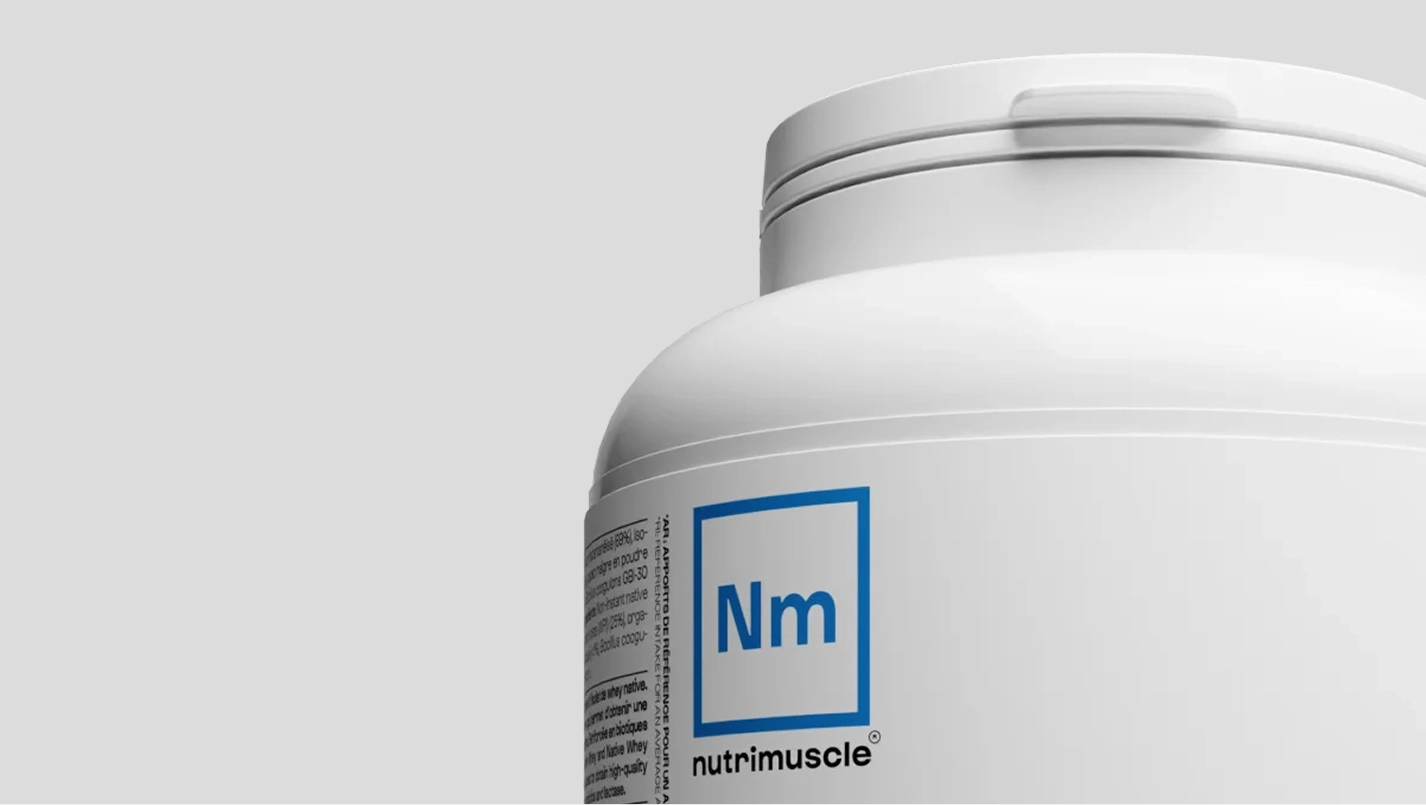


The popup framework for revenue
So, how do you treat popups as a revenue channel?
One efficient way is to try campaigns that have proven to work.
For example, this popup framework below is working for high-growth ecommerce brands, based on our experience. Note that those aren’t always simple popups, but multi-step workflows designed for engagement, progressive profiling, and selling.
Click the campaigns to see them in action:

Email & SMS
Turn new visitors into subscribers and collect their emails + phone numbers

Cart Upsell Popup
Offer a perfect add-on right after “Add to cart"

Shopping Suggestions
Personalized recommendations displayed on your product pages

NPS Survey
Get more survey results with an engaging and quick NPS survey

Black Friday Gamification
Gamify Black Friday offers to boost sales

Paid Traffic Retainer
Boost ROAS with a last chance exit offer for paid traffic
Proven tactics to use popups to increase ecommerce revenue
Here are proven tactics that ecommerce brands use popups to drive more sales and revenue. We’ll take a closer look at each one in the next section.
Tactic
Segment / personalization
Design
Trigger
Expected outcome
1. Multi-step welcome workflow
New visitors
Step 1: Email capture & offer Step 2: Phone & segmentation Step 3: Reveal discount code + highlight best-sellers
10 seconds on page
Faster product discovery > more add-to-cart > +8% signups, €1.8M popup-attributed revenue
2. Personalized AI product recommendations
First-time visitors who viewed 5+ products
AI-generated product recommendations based on browsing behavior
Exit-intent after 5+ seconds, 5 page views
Increase conversion 1–5%, reduce drop-off
3. Recover ad spend with exit-intent offers
Visitors from paid ads
Discount + personalized product recommendations
Exit-intent, page_views ≥4, time_on_site ≥8 sec
Recover paid traffic losses, increase conversions
4. Onsite cart recovery flow
Visitors with items in cart
Step 1: Cart contents + discount Step 2: Copy code / redirect
Exit-intent
Recover up to 5% more abandoned carts
5. Display “Frequently bought together” items when a customer adds a product to the cart
All visitors
Centered popup with 1–2 complementary items
Product added to cart (cart.items updated)
Increase average order value via relevant cross-sell
6. Encourage more spend with free shipping thresholds
All visitors below free shipping threshold
Side slide-in with amount needed + product recommendations
Cart updated (cart.total_price changes)
Increase order value, nudge to free shipping threshold
7. Promote bundle offers on product pages
New visitors on bundle-eligible pages
Popup with bundle offer, clear value proposition
On landing, after 3 page views, 5+ sec on page
Increase CTR & conversions on bundle products
8. Cart-based upsell offer to increase AOV
Visitors with 5+ page views, 1+ item in cart
Exit-intent popup recommending related products
Exit-intent, 5 page views, 10+ sec on page, cart.item_count >0
Increase average order value without being pushy
9. Exit-intent campaigns without discounts
All visitors with cart items
Scarcity message, option to save cart
Exit-intent, cart.item_count >0
Reduce cart abandonment rate
10. Convert visitors from email campaigns
Email newsletter subscribers
Personalized popup (e.g., advent calendar)
On page load, session includes UTM
Maintain messaging consistency, improve engagement
11. Convert high-intent browsers with time-on-page triggers
Visitors on product pages, 30+ sec
Social proof popup with bestseller & customer review
30 sec on product page
Boost conversion by validating product choice
12. Convert with a category-specific free shipping
Visitors browsing category pages
Popup with free shipping offer + coupon, category-relevant imagery
After 10+ sec on category page
Increase conversion, drive category purchases
13. High-value product promotion with social proof
New visitors, 2+ pageviews, cart value = 0
Exit-intent popup with 5-star rating + dedicated discount
Exit-intent + 30-sec delay
Reduce hesitation on premium products, increase conversions
14. Loyal customer exclusive reward
Logged-in repeat customers (orders_count ≥3)
Exclusive product access, limited offer
30 sec / 50% scroll depth
Increase perceived VIP status, drive larger AOV
15. Post-purchase accessory recommendation
Returning customers with past purchases
Accessory promotion with images, incentive
Login / return after purchase
Increase repeat purchase, cross-sell complementary items
16. New collection launch popup for product discovery
All visitors not yet seen collection
Lifestyle image + link to collection
After 2 page views site-wide
Accelerate discovery & engagement with new products
Revenue-focused popup strategy: 30-day implementation roadmap for ecommerce stores
Week 1: Getting started 
Install an ecommerce popup platform
Connect your Shopify account, email marketing app, and CRM for data sync
Set up proper revenue tracking and attribution
Launch Multi-step welcome workflow for new visitors (email + phone number capture, promote bestsellers)
Run A/B test with a control group on the welcome workflow to know the financial impact (traffic required: 30,000 visitors monthly)
Week 2: Segmentation 
Add AI product recommendations for new visitors (exit-intent after viewing 5+ products)
Add Onsite cart recovery flow (show live cart contents + incentive)
Add Display “Frequently bought together” items when a product is added to the cart
Week 3: Optimization 
Implement Cart-based upsell offer for visitors with items in cart (recommend related products on exit)
Add Exit-intent campaigns without discounts to recover abandoning visitors with scarcity messaging
Run A/B tests on highest-traffic popups (e.g., welcome flow, cart recovery, AI product recommendations)
Week 4: Analyze and improve 
Monitor popup performance with A/B testing: CTR, revenue attribution
Analyze performance in analytics dashboard and download reports
Adjust triggers, segmentation, and design based on data insights
Launch Category-specific free shipping popups or Bundle promotions on top-performing pages
Publish campaigns to promote your loyalty program; also, improve program participation with “double your points for purchasing” and similar campaigns
Strategy: Converting new visitors
Strategy: Shopping cart optimization
Strategy: Behavioral micro-moments
Strategy: Converting new visitors
Tactic 1: Multi-step welcome flow with bestsellers
This is the campaign that upgrades the traditional welcome popup.
With that, our only goal was to capture emails.
Now, we turn first-time visitors into buyers while capturing emails/phones and segmentation data and guiding them toward best sellers.
The workflow will have three windows, or “steps:”
Step 1: Email capture & offer: Present the value proposition and collect the visitor’s email
Step 2: Phone & segmentation: Gather phone numbers and preferences or segmentation data
Step 3: Incentive & product promotion: Reveal the discount code and highlight top-selling products to encourage immediate purchase
Let me show this workflow in action using Nutrimuscle.
The first step in their popup is basically a traditional welcome campaign—they clearly state our offer and invite the visitor to sign up with their email:


Next, we come to the phone number signup and the segmentation data collection part. This is where it gets more interesting.
The campaign asks multiple-choice questions that are quick and easy for visitors to answer in seconds. That’s the best format to reduce friction and keep the cognitive load light:


The third and final window gives the visitor the discount code. They can apply the code to the cart in one click by choosing Add.
But what’s really important here are the product recommendations—having them increases the chance of a visitor checking them out. By highlighting best-sellers like that, you guide visitors toward popular items, turning the first interaction into a potential sale:


This revenue-focused popup reported these results over 12 months:
Achieved an average conversion rate of 4.01%
Captured 7,600+ emails and 4,800+ phone numbers
Collected thousands of data points for customer segmentation
€1.8M in popup-attributed revenue generated along with a few other campaigns
Expert tip:
Create a dedicated version of this workflow with a simplified welcome message to display to returning visitors only—but this time, use a sticky tab.
The tab is a small teaser that will help you keep the discount easily accessible at all times and remove the frustration of having to show the same popup again to those who’ve seen it. This technique improves browsing experience and helps recover visitors who didn’t buy the first time.
Learn more about tabs.


How to implement this campaign:
Trigger: on landing
Segmentation: new visitors
Display condition: 10 seconds on page
Design: three steps with radio buttons and survey field
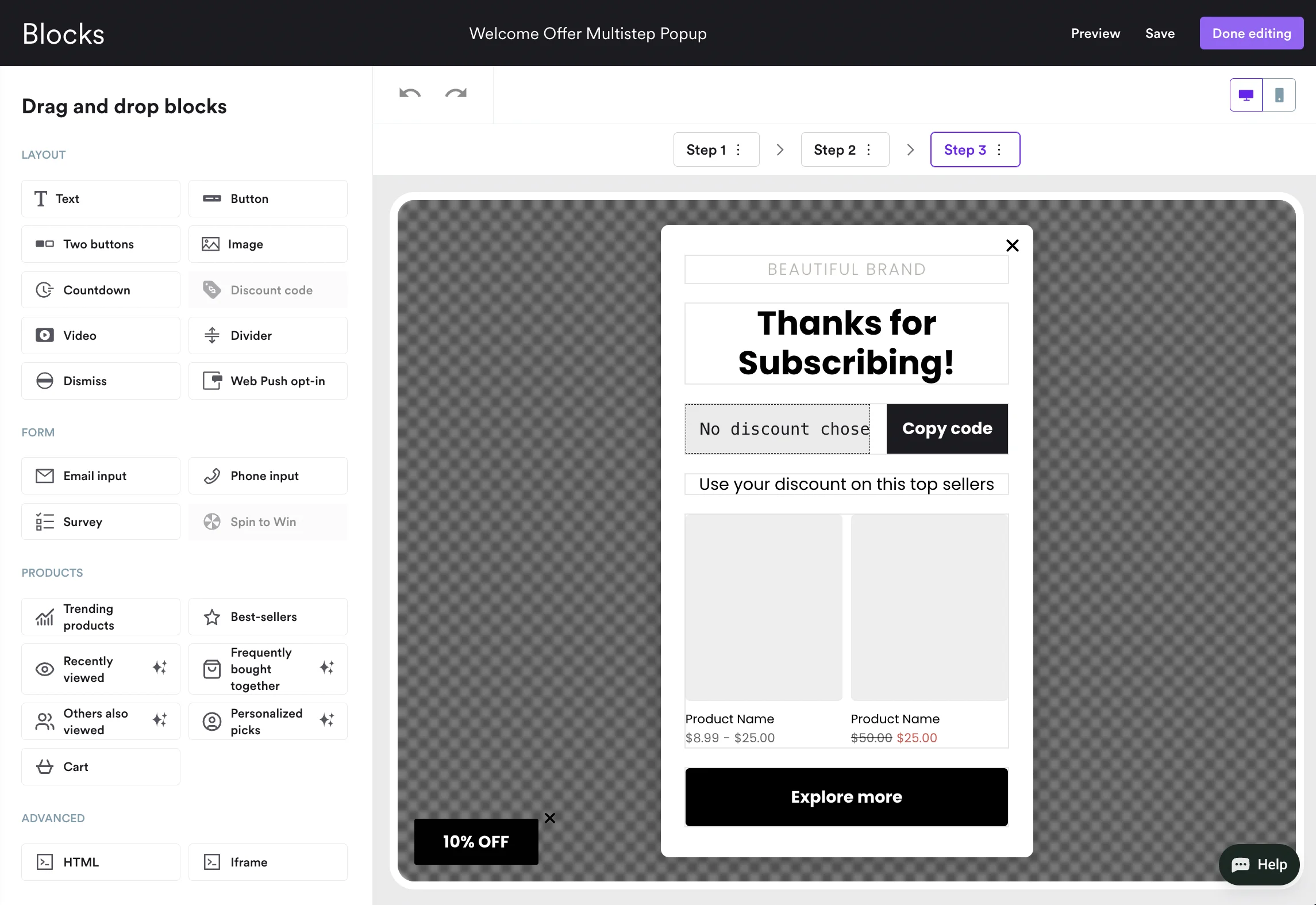

Tactic 2: Personalize product discovery with AI product recommendations for new visitors
New visitors often browse a few products without finding exactly what they want—especially if it’s a store with a large catalog.
So many of them may leave after viewing only five products or so.
Trigger an exit-intent popup that shows AI-made personalized recommendations based on the items they’ve already viewed. This increases the chance they’ll browse more products, add something to cart, and convert before leaving.


By combining behavioral targeting with AI personalization, you can increase relevance, reduce drop-off, and improve the chances of converting first-time visitors without discounts.
Campaigns like this one can lift revenues by up to 5%, based on our experience working with Shopify businesses.
Implementation:
Trigger: on exit, 5+ seconds on page
Segmentation: new visitors
Display after: 5 page views
Note: AI product recommendations in Wisepops are available only for Shopify.


Tactic 3: Recover ad spend with exit-intent offers
When you're spending money to drive traffic from Facebook, Google, or other paid channels, losing visitors is literally watching your ad budget disappear.
You can make an exit-intent campaign to specifically target paid traffic sources, triggering a last-chance offer with a discount and personalized product recommendations when visitors attempt to leave.


Since ad visitors have higher acquisition costs and deserve extra conversion effort, we combine a discount with product suggestions based on browsing behavior. This way, you address two important barriers: price and decision hesitation.
Implementation:
Trigger: exit-intent
Traffic channel: paid search
Display conditions: page_views >= 4 AND time_on_site: 8 seconds
Frequency: Once per visitor
Note: If you also want to use this targeting for paid campaigns on social media, another way to do so with UTM parameters.
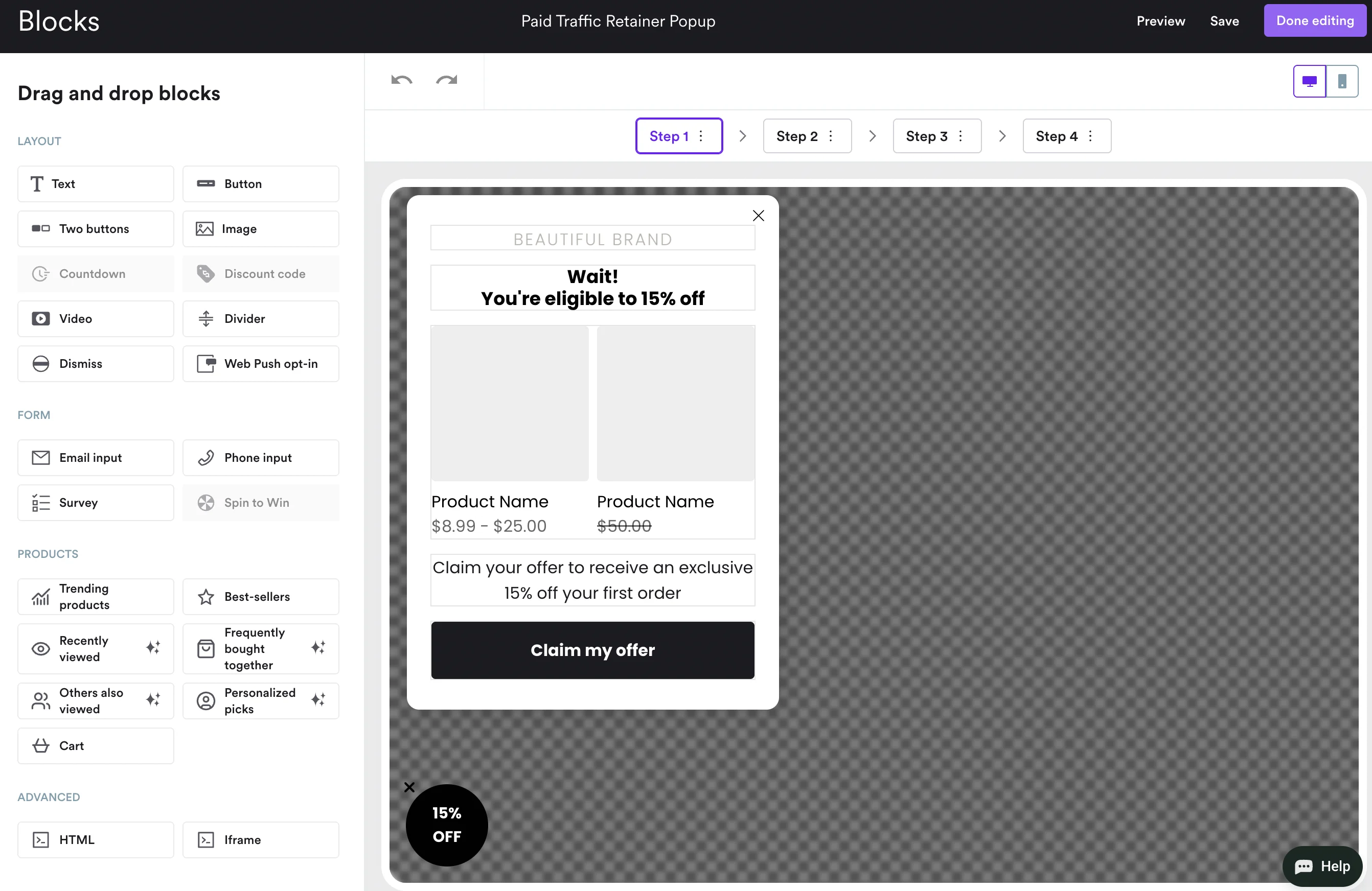

Tactic 4: Onsite cart recovery flow (Shopify only)
A simple exit-intent campaign can work as a cart recovery popup, but it often needs to be smarter to achieve a good recovery rate.
Instead, consider this workflow for both desktop and mobile—
This campaign appears on exit and shows visitors exactly what they're leaving behind (their actual cart contents added to the popup in real time). Also, the countdown timer and a discount add some more motivation:
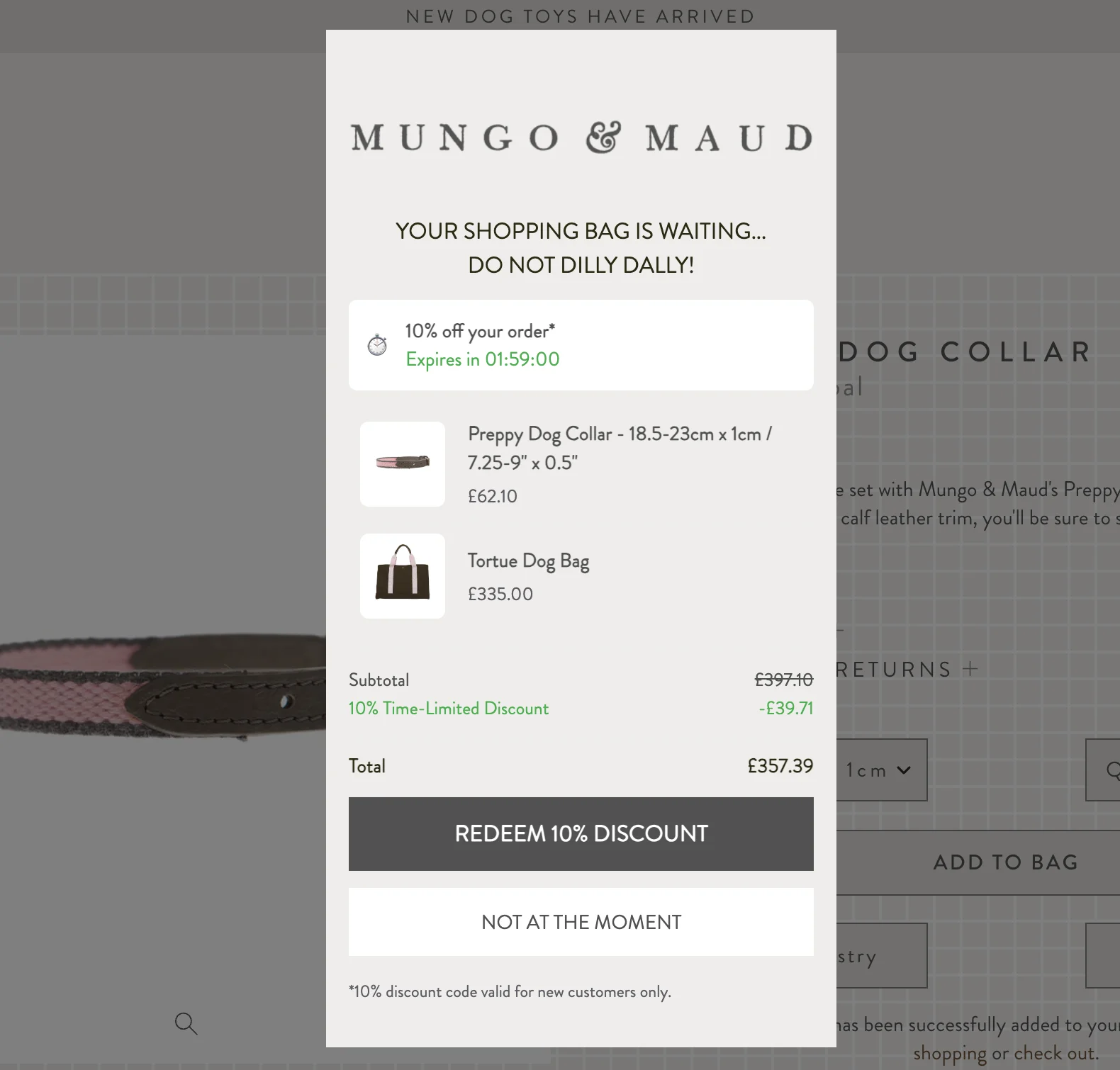

If the customer chooses to receive the discount, they get the second window. There, they can easily copy the discount code. If they do, they will be automatically redirected to the cart page.
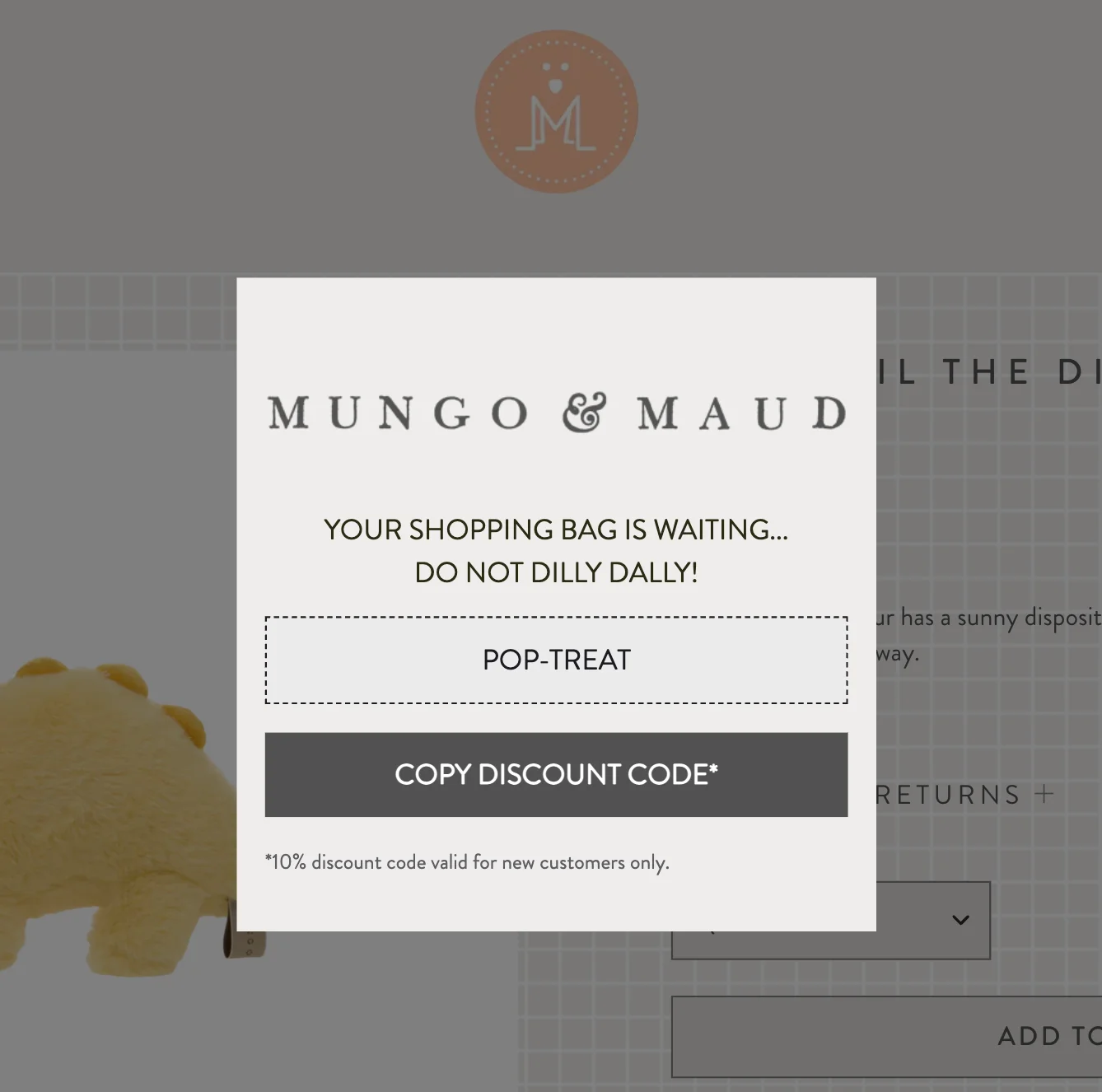

There are a few ways to implement effective cart recovery popup workflows.
The first one is to use the cart content reminder + an incentive (just like in the above example). You set it up by adding a cart content block inside an exit campaign in advanced popup software like Wisepops.
The "live cart content" component (in the image below) ensures accuracy, so no manual updates are needed:
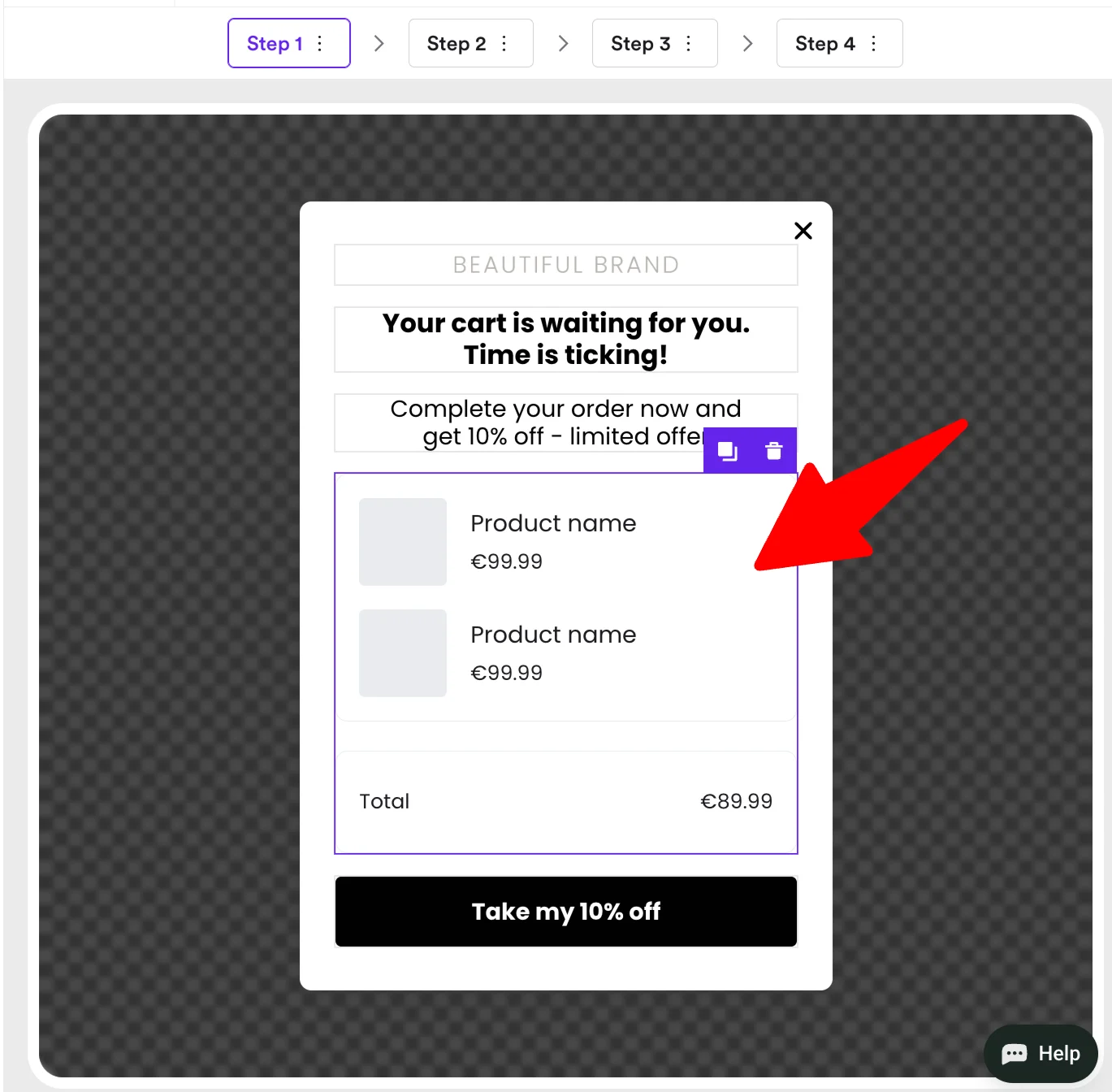

Next, you can also create smart campaigns with AI.
When your campaign design is done, enable AI-powered exit detection to make your offer as contextual and relevant as possible:
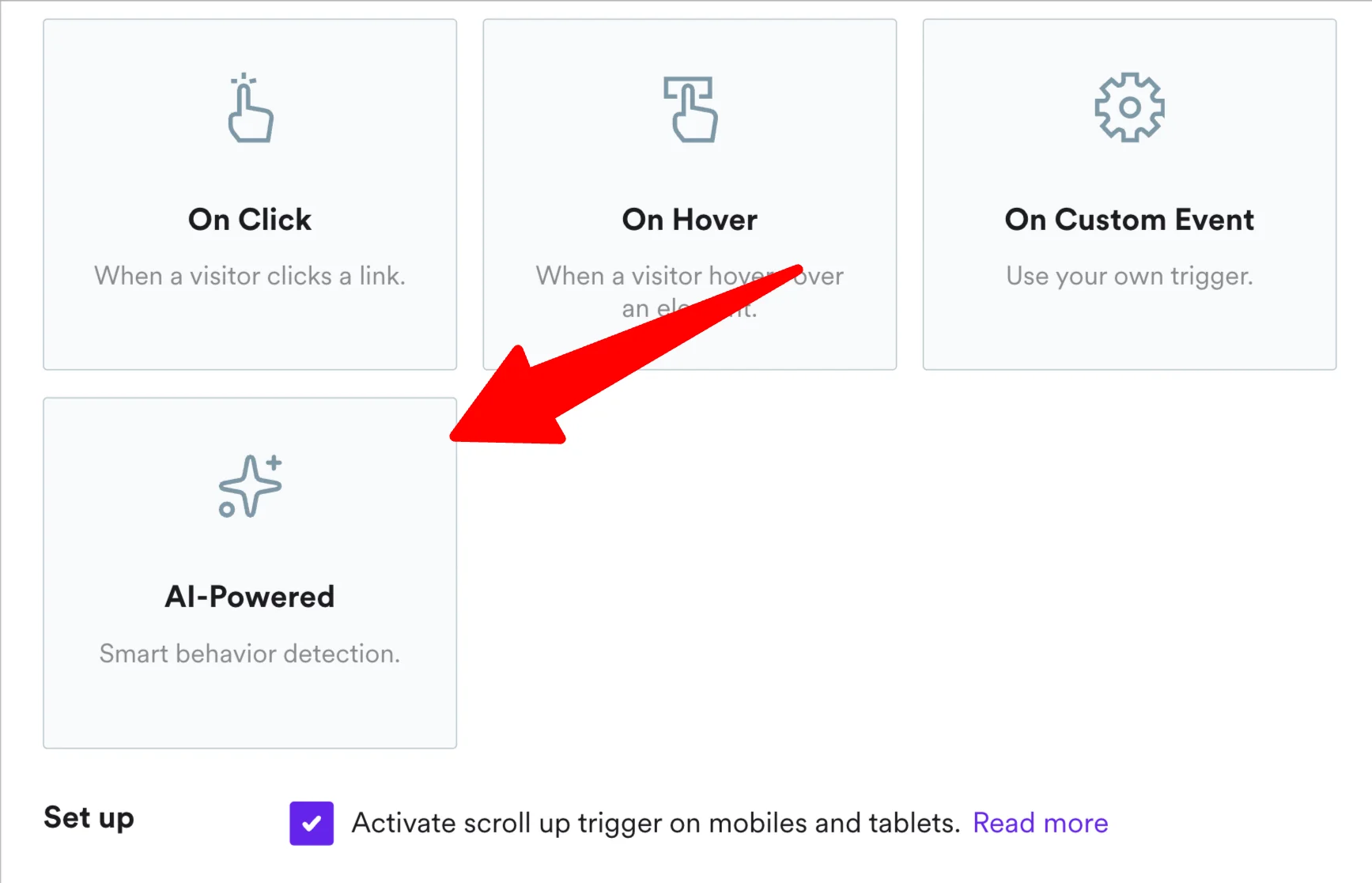

The third way is to use the native Shopify cart content and/or value targeting settings.
You segment customers based on the value or number of products currently in their cart. Use cart.item_count and cart.total_price properties. For example, you can show your offer only to those whose products in the cart are worth more than $50:


Pro tip: Make a dedicated offer for high-value orders
For orders over $100, your primary goal is to protect your margin. Consider using a targeted exit workflow that offers a value-add instead of discount (e.g., free expedited delivery, double loyalty points, a premium gift).
Strategy: Shopping cart optimization
The moment someone adds an item to their cart, your popup strategy should shift from discovery to conversion rate optimization.
Tactic 5: Display “Frequently bought together” items when a customer adds a product to the cart
Once a customer adds items to the cart, suggest complementary products based on actual purchase patterns. This isn't random cross-selling but a data-driven product bundling that increases average order value in a natural way.
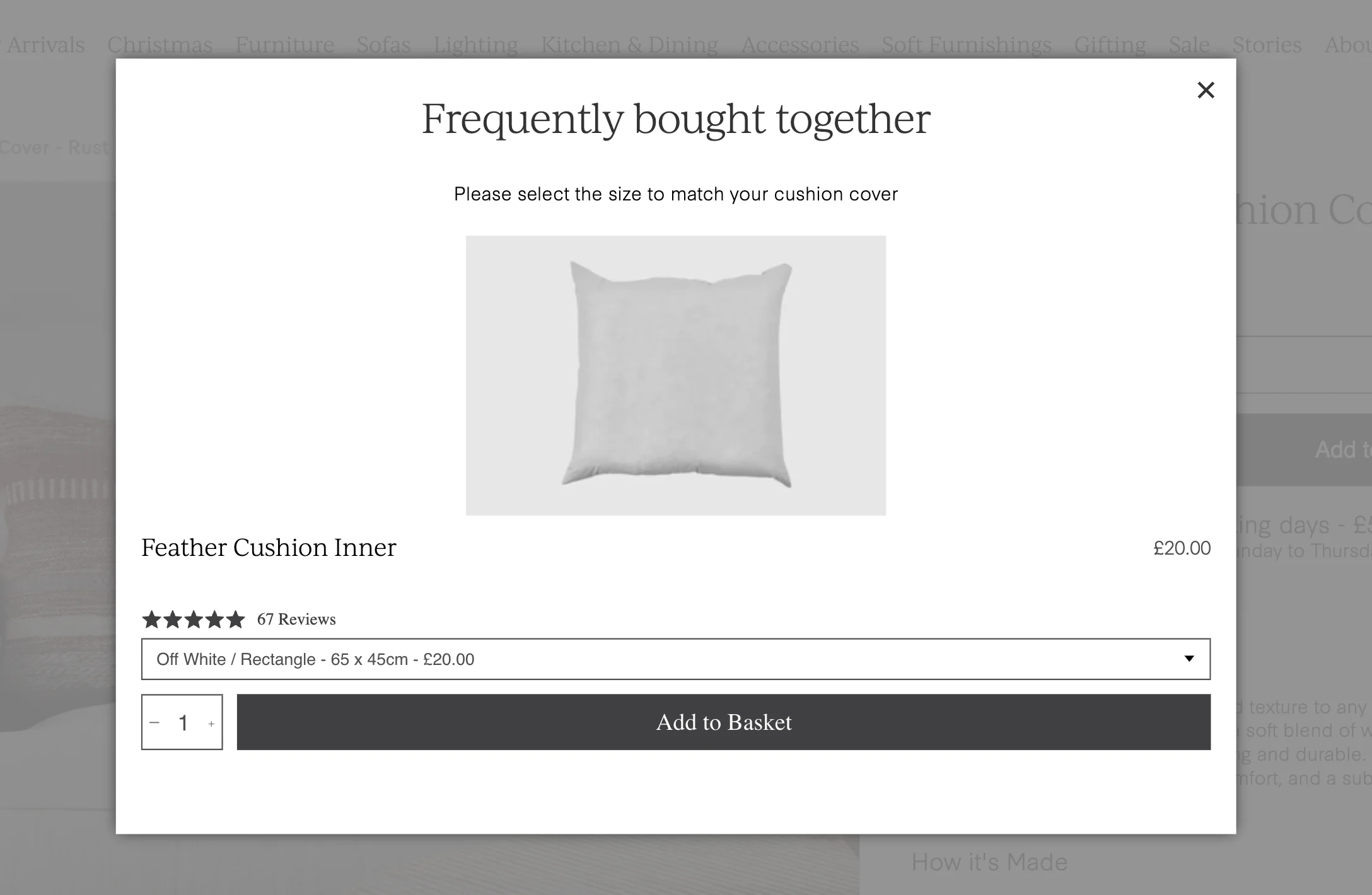

Implementation:
Trigger: product added to cart (cart.items property updated)
Audience: all visitors
Display conditions: cart.items contains the target product
Frequency: once per visitor per session
Placement: a centered message on product pages
Content: display one or two complementary items most frequently bought with this specific product, with images, prices, and “Add to cart” buttons for one-click cart addition.


Tactic 6: Encourage more spend with free shipping thresholds
Encourage visitors to increase their order value to get free shipping by using native Shopify display rule cart.total_price in your popups.
For example, you use cart.total_price to trigger messages like "Add $15 more for free shipping" when visitors haven't reached your chosen threshold.
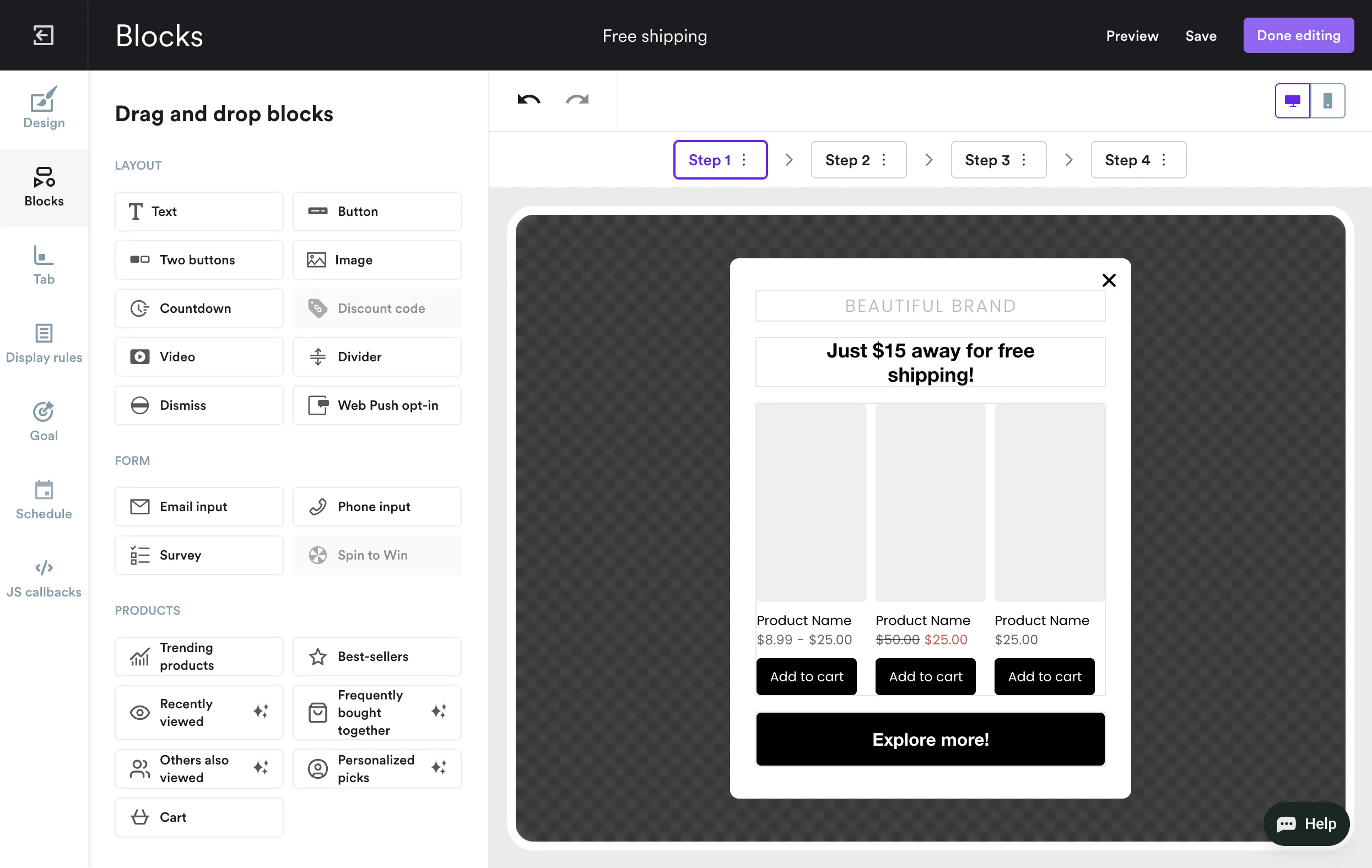

Implementation:
Trigger: cart updated (cart.total_price changes)
Traffic channel: all visitors
Display conditions: cart.total_price “is less than” free shipping threshold (e.g., $50)
Frequency: once per visitor per session
Placement: side slide-in on product pages
Content: message showing how much more the customer needs to add to get free shipping, e.g., “Add $15 more to get free shipping,” with product recommendations
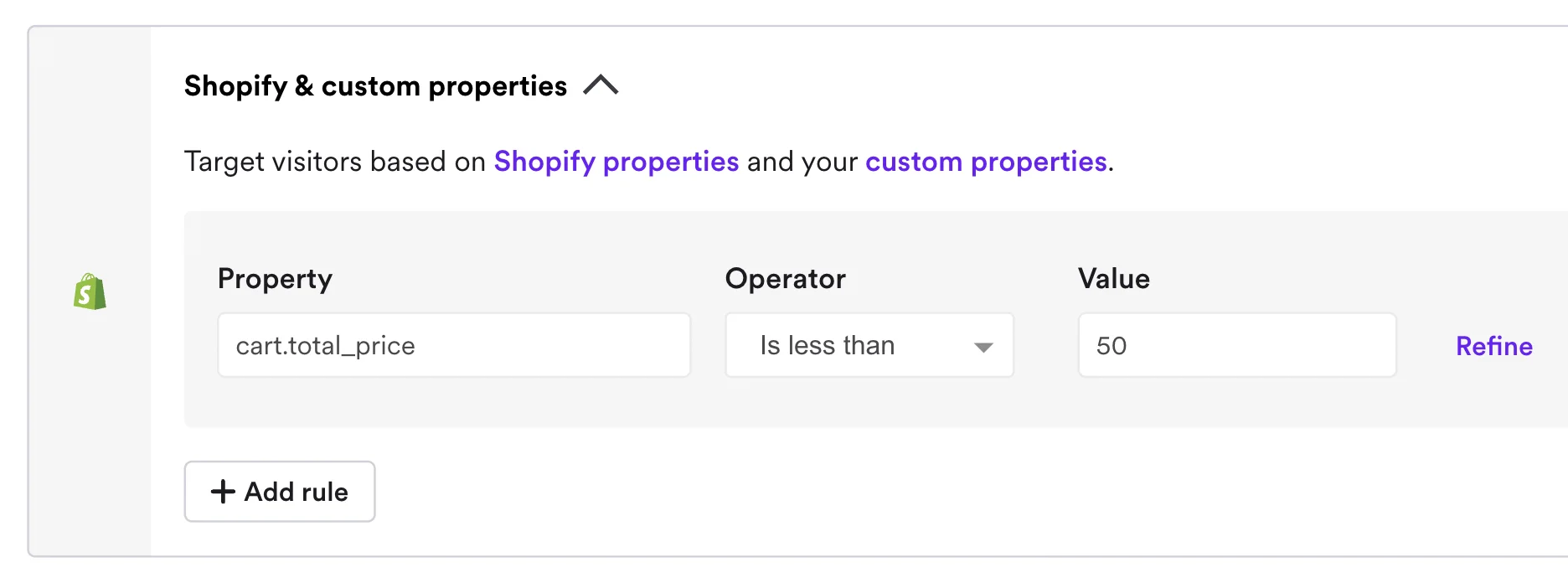

Tactic 7: Promote bundle offers on product pages
If your store sells bundles, promote them on relevant product pages with a dedicated popup. For example, MakerFlo uses a similar campaign to let visitors know about bundle savings.
With this campaign, MakerFlo reached 22.9% CTR, with 14.7% of those clicks converting to orders. The key was to target specific product pages and make the value proposition clear: save 10% by creating your own bundle.


Implementation:
Trigger: on landing, 5+ seconds on page
Segmentation: new visitors
Display after: 3 page views
Browsing history: Products that are eligible for bundling (URL contains ‘products’)


Tactic 8: Cart-based upsell offer to increase average order value
When visitors add products to cart, it’s a great moment to recommend some related items. This exit popup idea targets active shoppers who've viewed at least five product pages and added at least one item to the cart, recommending related products to add to their purchase.
The campaign timing is strategic: triggering on exit after engagement (5 page views, 10+ seconds) ensures you're reaching potentially interested buyers, not just casual browsers. By showing products that pair with their cart contents (like in this example below, skincare items that complement each other) you increase AOV without being pushy.
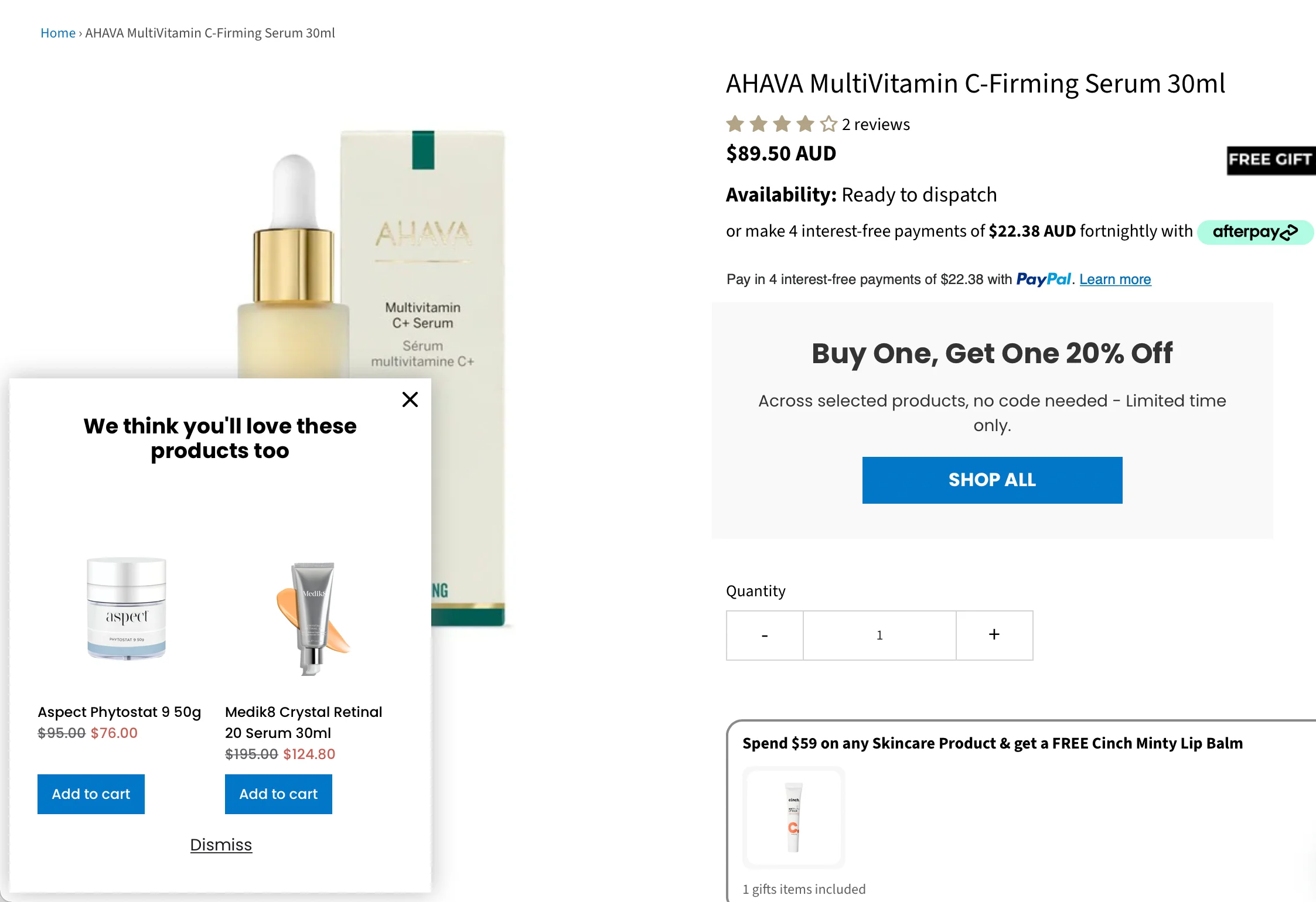

Implementation:
Trigger: On exit
Display after: 5 page views; 10 seconds on page
Browsing history: Product pages only (URL contains ‘products’)
Shopify cart targeting: Cart.item_count > greater than 0


Strategy: Behavioral micro-moments
The most sophisticated popup strategies respond to micro-behaviors on websites that indicate purchase intent or hesitation.
Tactic 9: Exit-intent campaigns without discounts
Instead of giving a discount for each leaving visitor, remind them about their cart and give a reason to stay. "These items are selling fast" or "Your products are saved only for 24 hours" can be more effective than another 10% off.
This popup, for example, uses the scarcity technique and says that the availability of products can’t be guaranteed beyond 24 hours:


This next campaign uses trust and hesitation-reducing messaging, highlighting benefits such as free returns, fast delivery, and flexible payment options:


Implementation:
Trigger: Exit-intent
Display conditions: cart.item_count > 0
Traffic channel: All visitors
Frequency: Once per session
Design: give an option to save the cart by signing up


Tactic 10: Convert visitors coming from email campaigns
When visitors arrive from your emails, they’ve already shown intent, so there’s no point in greeting them with the same generic popups. Instead, continue the conversation from their email inbox with a personalized message onsite.
Say, you can use a holiday-themed advent calendar to drive engagement during the festive season. Only customers who click those emails and land on your site will see the calendar inviting them to unlock today’s reward.
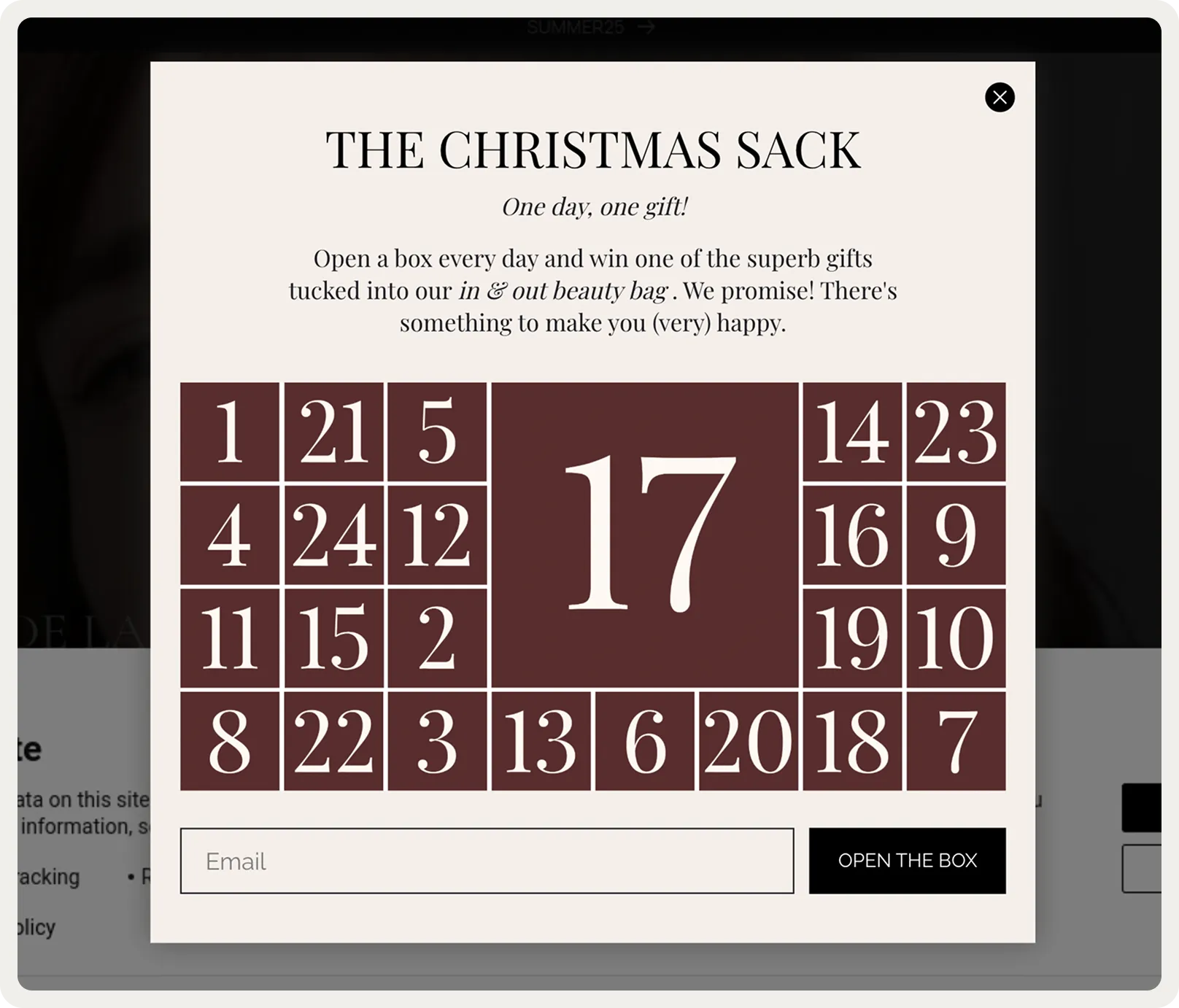



In popup software, you can target visitors based on the exact campaign or subscriber segment they came from. This keeps your marketing messaging consistent and improves personalization.
Example: in ecommerce popup software like Wisepops, you can use UTM parameters as a traffic source or target your specific Klaviyo subscriber segments.


Implementation:
Trigger: on page load
Traffic channel: UTM source = newsletter, UTM campaign = advent-calendar
Display conditions: visitor session includes UTM parameters
Frequency: once per day per visitor
Placement: centered popup for maximum visibility
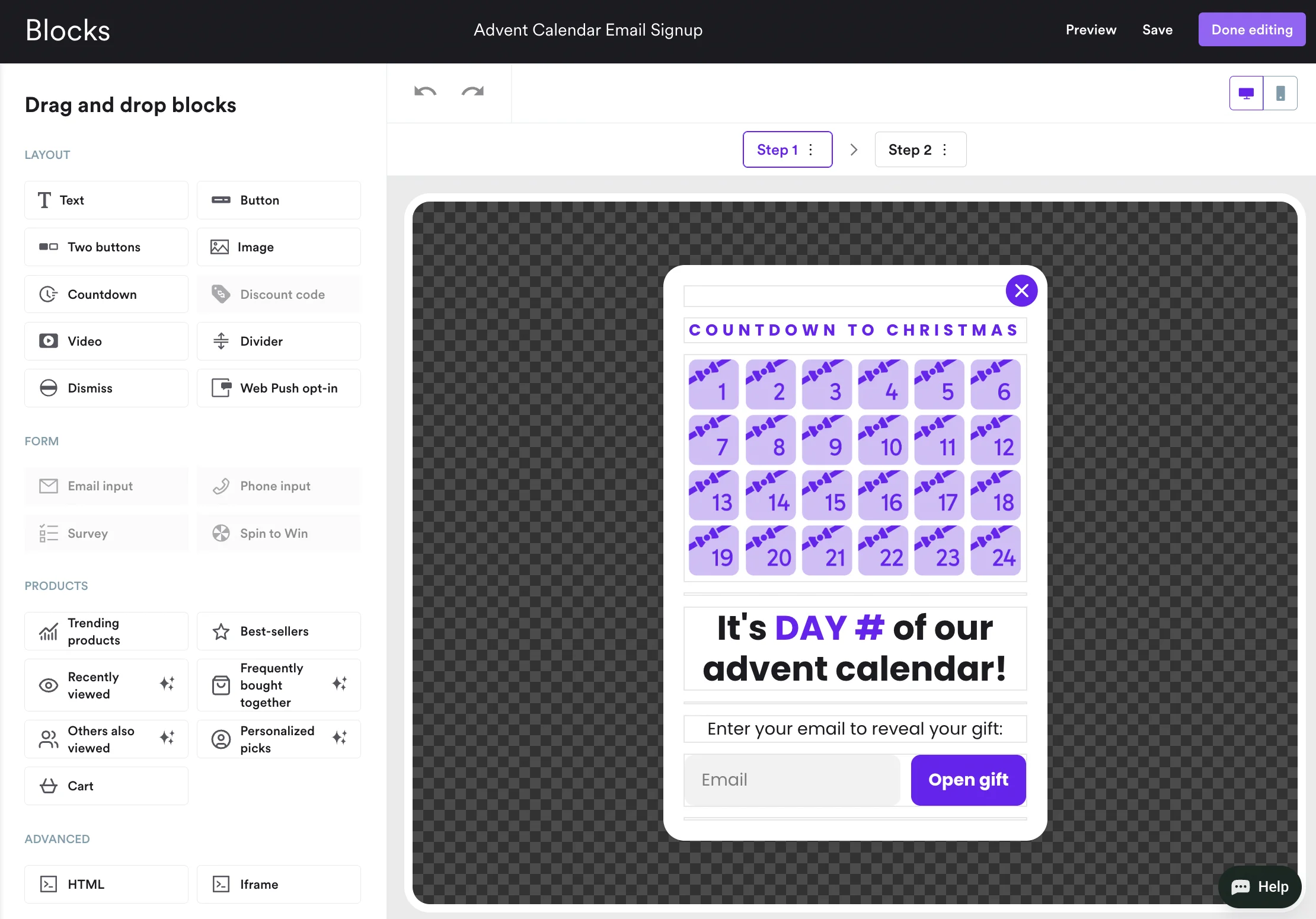

Tactic 11: Convert high-intent browsers with time-on-page triggers
If someone's been on a product page for 30+ seconds, they're interested but need a push. The extended time on page signals consideration, so this is a great moment for social proof popups showcasing expert recommendations or customer favorites.
This popup tactic works because it intervenes at the decision-making peak. We wait until we prove possible buying intent, then give the validation needed to convert. By highlighting a product chosen by a team of professional athletes in this campaign below, the brand builds confidence without discounting.


Implementation:
Trigger: 30 seconds on page
Page: Pages containing “product name” in URL
Frequency: Once per product per session
Design: Include one bestseller with some social proof: customer review or expert endorsement.


Tactic 12: Convert with a category-specific free shipping
In this one, we target visitors browsing a specific product category and motivate them to buy with a free shipping offer. By adding this popup on category pages rather than homepage, we are likely to catch high-intent shoppers already interested in specific products.
The coupon code field also allows us to track the performance of this campaign. The visual at the bottom also shows the actual product category, creating contextual relevance that generic popups lack.


Implementation:
Trigger: After 10+ seconds on page
Page targeting: URL contains /collections/ or /categories (or other category slug)
Display: once per visitor
Exclude: Visitors who already have items in cart
Design: Feature category-relevant imagery and reminder about when the offer expires (e.g., "Until 28 August 2025") to create urgency.


Tactic 13: High-value product promotion with social proof
This is a strategic exit-intent popup made to capture abandoning visitors by promoting a specific product (premium diffuser) with a dedicated discount. What differentiates this campaign is the section with a 5-star rating and 371 reviews, which immediately validates quality, reducing hesitation for buyers.
This campaign may be particularly effective for expensive products where trust-building is essential for getting sales.
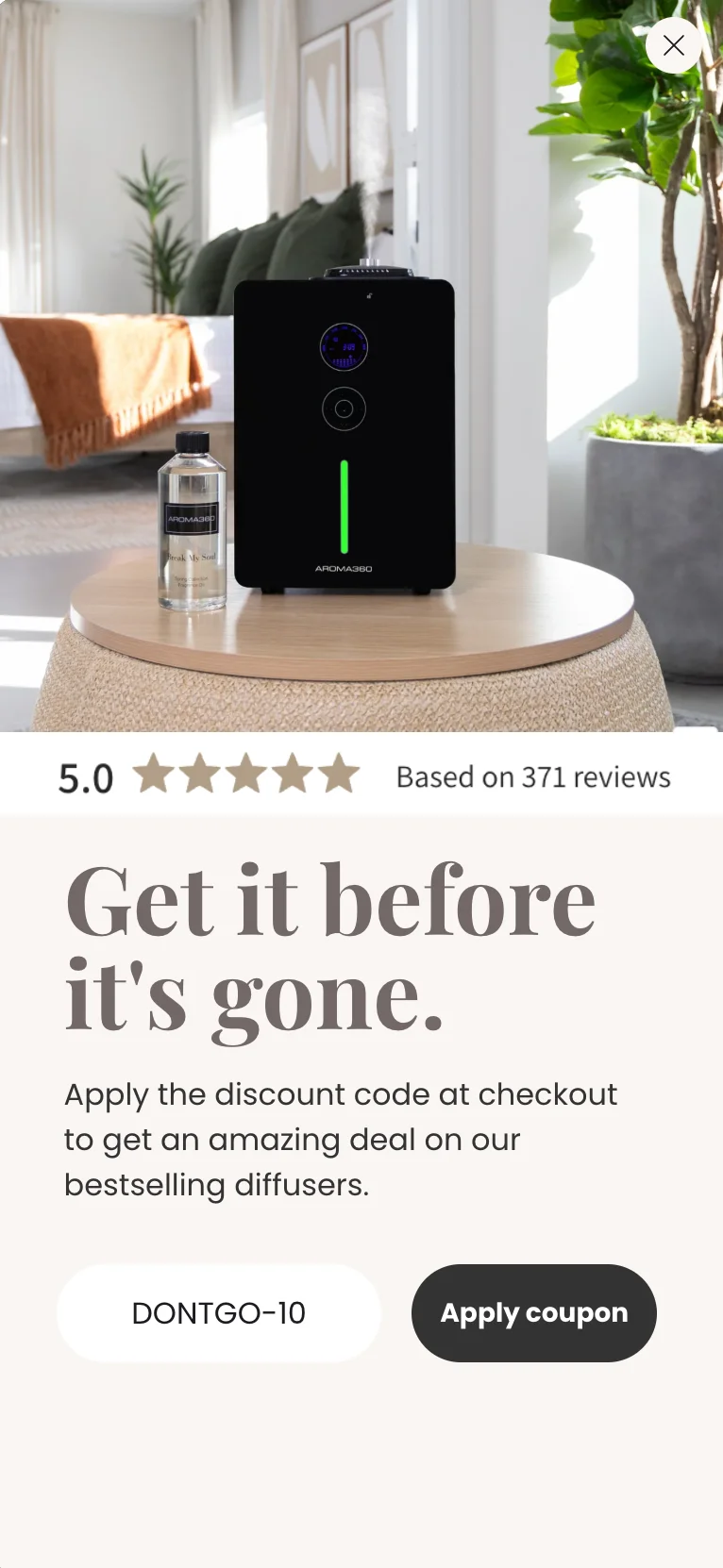

How to implement this popup:
Trigger: exit-intent + 30-second time delay
Targeting: Display on product pages and homepage; exclude cart and checkout
Audience: New visitors only, all devices, once per 7 days frequency cap
Display Rules: Show when cart value = $0 and more than 2 pageviews
Tracking: Monitor CTA clicks and coupon code redemptions at checkout


Tactic 14: Loyal customer exclusive reward
With this popup, you can target repeat customers (using customer.orders_count > 3 + customer.is_logged_in = true in your Shopify targeting settings). Instead of discounting, we reward loyalty with exclusive product access—preserving margins while driving higher average order value.
This idea is great for new product launches, inventory clearance for loyal customers, and selling seasonal exclusive products. This visitor conversion approach increases perceived VIP status while encouraging larger cart size without eroding brand value through discounts.


Implementation:
Trigger (native Shopify display settings): customer.orders_count >= 3 AND customer.is_logged_in = true
Add cart value condition: cart.total < 100 (show before our threshold is reached)
Timing: Display after 30 seconds or 50% scroll depth


Tactic 15: Post-purchase accessory recommendation
After a customer completes a purchase, their next visit to your website is a great opportunity to offer related products they haven’t bought yet. Using past purchase data (orders.*.items.*.sku), you can target customers who purchased a core product (e.g., a coffee machine) but haven’t bought its complementary accessories (e.g., coffee filters or capsules).
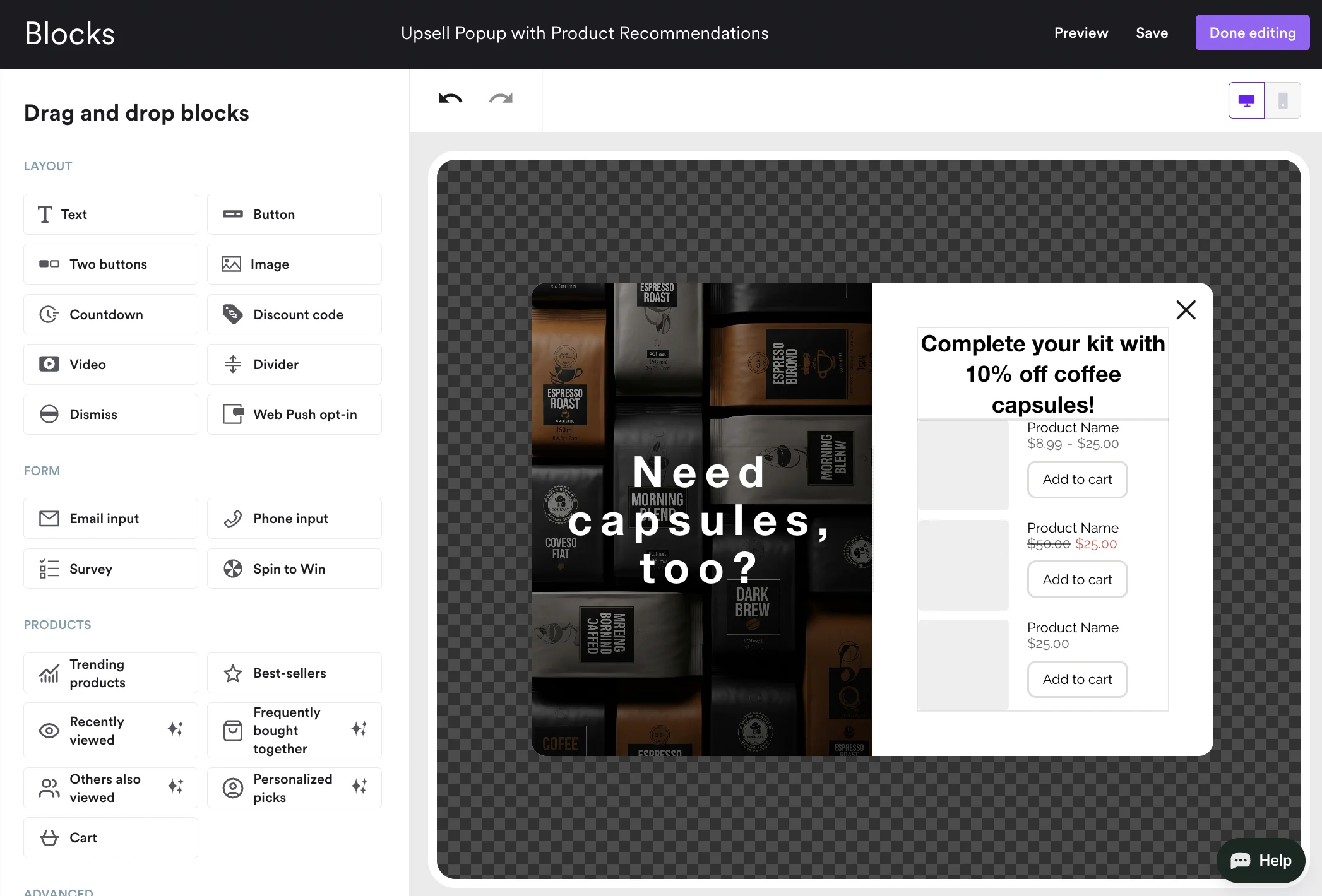

Implementation:
Trigger: visitor logs in or returns to site after purchasing product X
Traffic channel: returning customers with purchase history
Display conditions: orders.*.items.*.sku contains purchased item X AND does not contain related accessory item Y
Frequency: once per visitor
Placement: center modal or side slide-in on homepage, product pages
Content: promote the accessory with images, a brief description, and an incentive (e.g., “Complete your kit with 10% off coffee capsules”)


Tactic 16: New collection launch popup for product discovery
This popup campaign promotes a new product color to drive awareness and sales of fresh inventory. By highlighting a specific collection with an aspirational lifestyle image, this simple campaign turns an announcement into a revenue opportunity.
The main benefits of this campaign is an active introduction of the new collection to all visitors, accelerating the discovery cycle. So if you’d like to raise awareness of new products and collections instead of relying on passive website browsing, this idea could be for you.


One variation of this tactic is with an exit campaign containing some trust signals:


Implementation:
Trigger: After 2 page views site-wide
Frequency: Show once per visitor during launch period
Exclude: Visitors who've already viewed the new collection page (URL contains “collections/name”)
Button: Link directly to the collection page for immediate shopping


Proving true incremental ROI of popup campaigns
The true measure of your popup strategy success is the net profit lift. Measurement must move beyond basic conversion tracking to prove profitability and your investment into a popup tool.
Let’s see how you can test the true impact of your campaigns on customer behavior and exclude sales that would have happened anyway.
Proving popup campaign profitability: A/B testing with control groups
The risk of cannibalization, or giving a discount to a customer who would have converted anyway, or is a common and a big threat to your margins. There are two important things to do to minimize this risk and get the data on incremental revenue.
Implement A/B testing with control groups
When testing a campaign, say a discount for new customers, add a control group that sees no popup to your A/B experiment. This helps you isolate the impact of the discount.


Measure revenue per visitor
Ecommerce popup platforms with advanced A/B testing calculate revenue generated by each visitor in all tested campaigns automatically.
To know the real impact, compare the Revenue per Visitor of your test group (say, variant A with 10% off) against the control group (Variant C, no campaign displayed).
The difference between these two groups is your Incremental Revenue—the extra revenue generated only because of your campaign.
And—
If the lift is significant, the discount was required to unlock more revenue
If the lift is negligible, deactivate the discount right away. The campaign is costing you margin
Many popup software have A/B testing, but only the most advanced ones for ecommerce include control groups. Example: Wisepops calculates revenue per visitor for every variant to help you understand how to optimize for profitability:


Popup metrics for incremental ROI: checklist
Track these KPIs to understand your popup performance and optimize:
Attributed revenue: direct sales within 24–48 hours after interacting with popups
Conversion rate by segment: new vs. returning, source/medium, etc.
Incremental lift: revenue from test variant vs. control (no popup)


How to segment your popups for higher revenue
Here's where many businesses fail: they treat all visitors the same. Your popup strategy should be as segmented as your email campaigns.
Customer lifetime value
Use customer.orders_count and customer.total_spent campaign targeting properties in your popup software to personalize campaigns.
For example:
First-time buyers (orders_count = 1): Welcome them to your community with a special offer, discount, and other incentives
Loyal customers (orders_count > 3): Consider skipping discounts and offering incentives like early access to new products, free gifts, and exclusive bundles
High-value customers (total_spent > $500): use popups to deliver experiences that feel exclusive: personalized product recommendations, early access to new products, curated product sets, etc.
New vs. returning visitors
New visitors
Your goal is to convert potential interest into action. Use popups to guide them to your best sellers, show AI-powered recommendations based on trending or top-performing products, and build trust with social proof, reviews, or satisfaction guarantees.
Returning visitors
These visitors already know your brand, so your popups should be more focused on driving purchases. Use contextual popups based on browsing history, abandoned carts, or cart content. Use popups to suggest complementary products, personalized bundles, or limited-time offers.
Learn more about visit frequency targeting.


Browsing history-based
Track page views and product interactions to deliver relevant offers. Choose pages to show your popups on—and exclude those where they would be irrelevant.
This is easy to do with popup software: more about page targeting
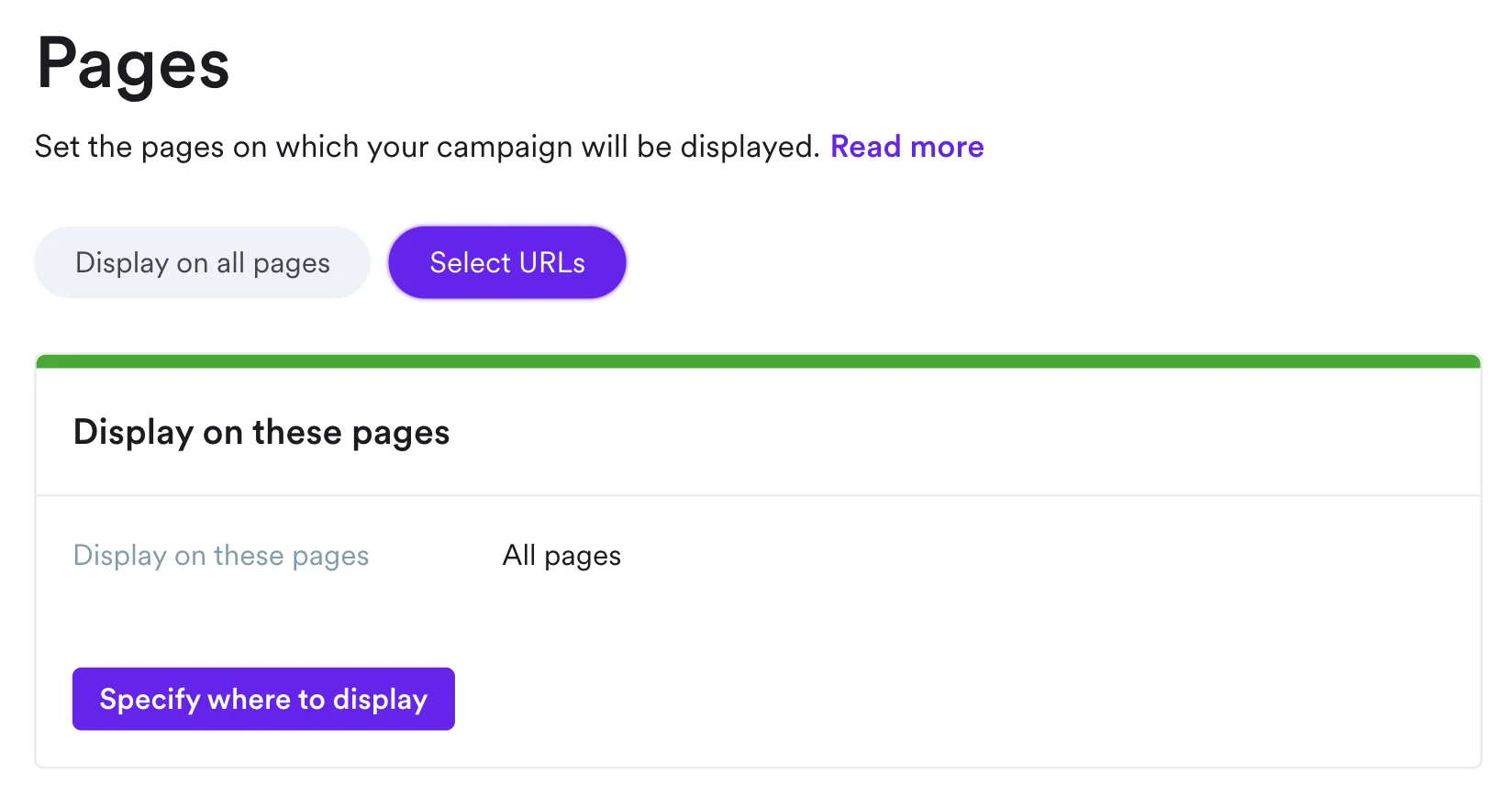

Logged-in vs. unregistered visitor targeting (Shopify only)
The customer.is_logged_in property could be a game-changer for you because you can give them personalized offers. For logged-out users, focus on account creation benefits beyond discounts—saved carts, order tracking, exclusive access, etc.
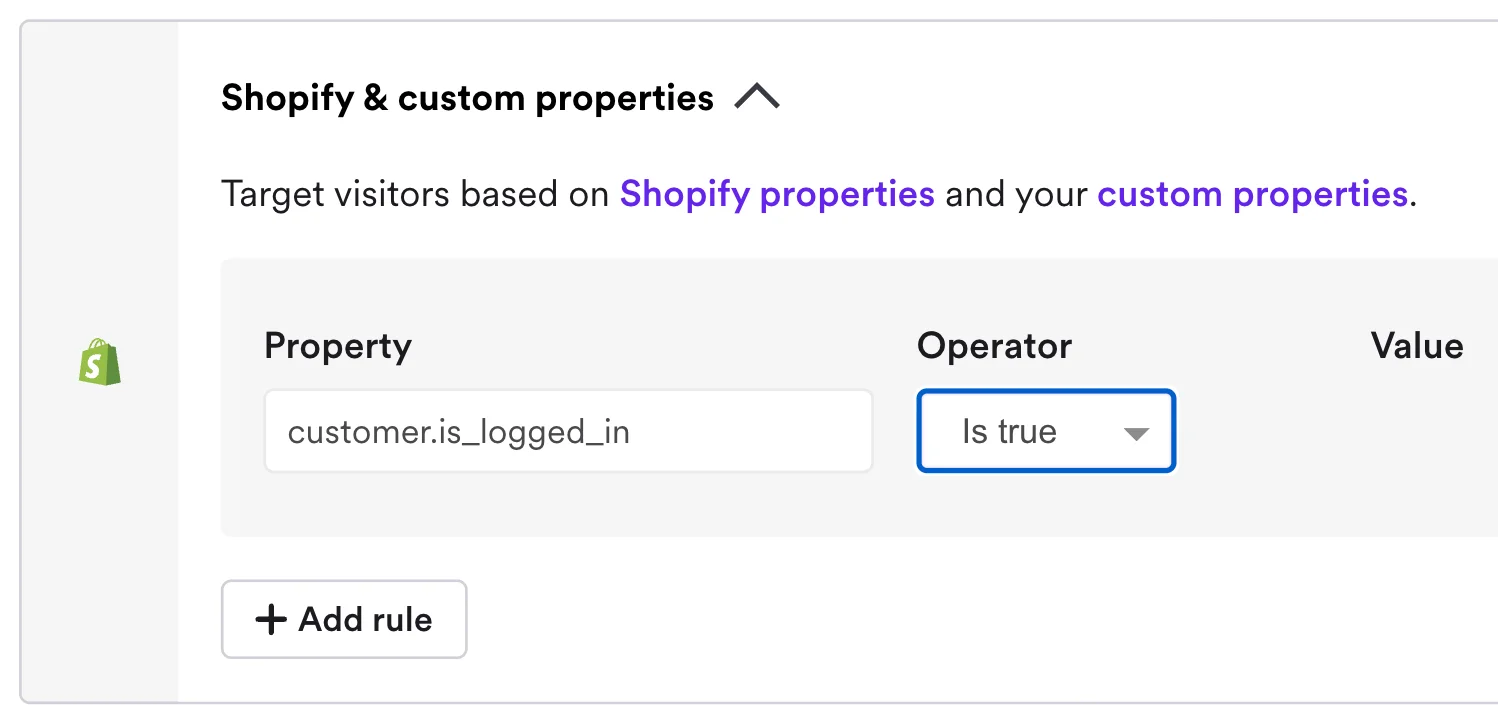

Customer tag-based personalization (Shopify only)
"Customer.tags" opens many possibilities for popup personalization on Shopify. You can tag customers based on their preferences and past purchases and then create popup experiences that feel personal.
Example: a “coffee_lover” tag triggers recommendations for premium beans, coffee machines, or brewing accessories, while a “tea_enthusiast” tag is perfect for showing teapots, loose-leaf teas, and infusers.
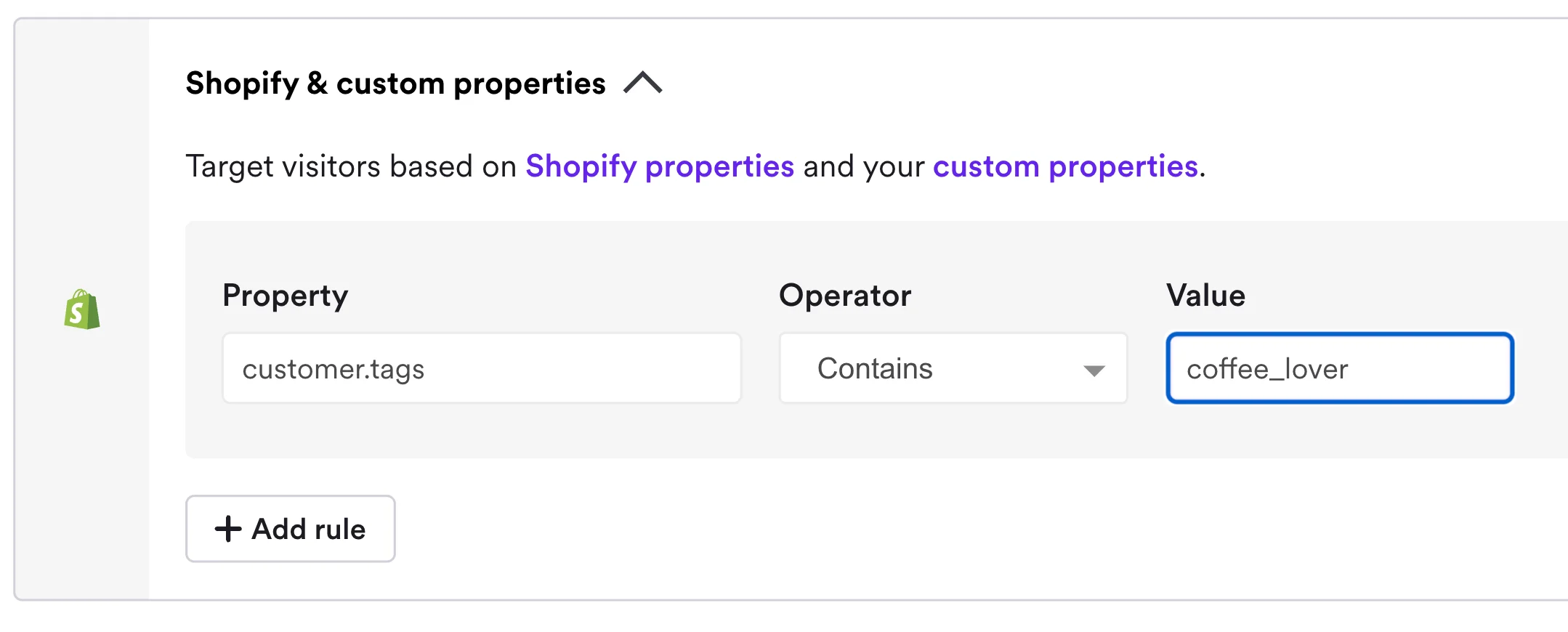

Cart-based targeting
Target visitors based on cart value, specific products, or cart abandonment risk. Say, someone with $100+ in their cart deserves a gift offer, not a 5% discount. Empty cart visitors need product discovery, while high-value carts may need some friction removal.
Here are all popular cart-related targeting options:
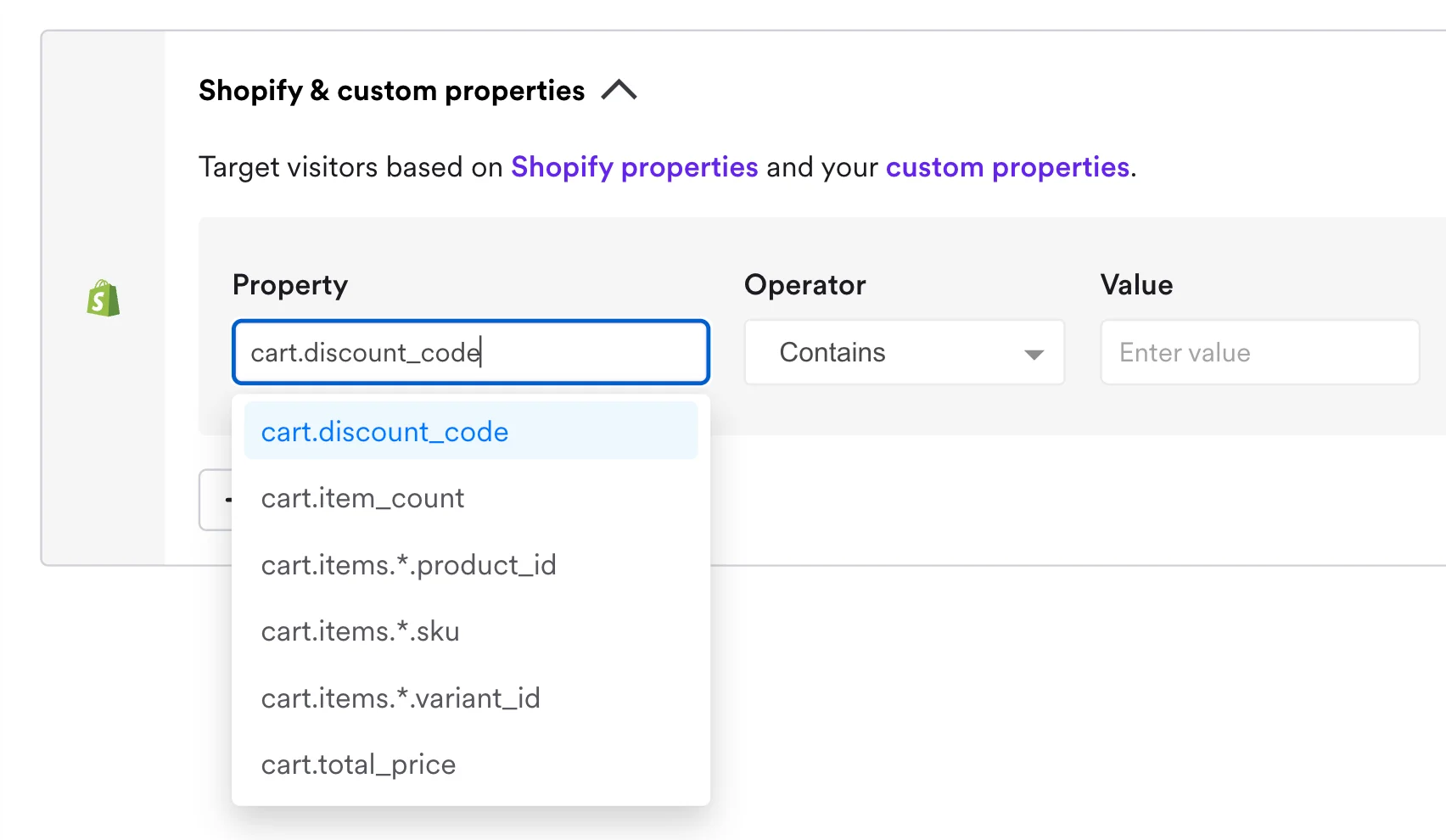

Geographic and device targeting
Use location and device data to make your popups more relevant. For example, you can highlight international shipping times or location-based offers. Also, personalize experiences by device: on mobile, use thumb-friendly popups with minimal inputs and large buttons.


How to write popup messages that drive revenue
The difference between a 1% and a 20% conversion rate often comes down to copy. In fact, in our A/B experiment research, we consistently find that campaigns with better messaging outperform image-only or design tweaks by up to 68% of cases.
Write meaningful urgency into your copy
Urgency-based popups still drive action, but fake countdowns and aggressive tone don’t. That’s why it’s better to use real, contextual urgency linked to behavior or session timing.
Instead of: “Hurry! Sale ends soon!”
Consider: “Your cart expires in 2 hours. Complete your order to lock in today’s price.”
 In multiple recent Wisepops A/B popup experiments, real-timed urgency (based on cart sessions) lifted engagement by 18% and reduced bounce rate by 12% on average.
In multiple recent Wisepops A/B popup experiments, real-timed urgency (based on cart sessions) lifted engagement by 18% and reduced bounce rate by 12% on average.
Highlight what the customer gains immediately
How you present an incentive can make a huge difference in ecommerce popup engagement. For example, instead of “Sign up for exclusive offers,” make the value tangible and immediate.
Examples:
Free gifts: “Get a free reusable tote with your first order”
Early access: “Be the first to shop our limited-edition collection—2,847 members already claimed early access”
Exclusive bundles: “Complete your kit with this curated bundle at a special price”
VIP perks: “Unlock free shipping for the next 30 days when you join our VIP club”
 Our research shows that “Free gift” incentives consistently outperform % discounts—capturing 2.7% of visitors vs 1.7%—and lift revenue per visitor by up to +24% in some A/B experiments.
Our research shows that “Free gift” incentives consistently outperform % discounts—capturing 2.7% of visitors vs 1.7%—and lift revenue per visitor by up to +24% in some A/B experiments.
Use real, specific social proof statements
Trust is the final push to conversion. Highlight real customers, quotes, reviews, and ratings instead of vague credibility claims.
Examples:
Fashion & apparel: “Over 12,000 shoppers rated our jackets 4.8 stars last month”
Beauty & skincare: “97% of customers saw visible results within 2 weeks”
Electronics & gadgets: “5,200+ happy users upgraded to our latest smart speaker this month”
Home & kitchen: “Rated 4.9 stars by over 3,400 home chefs”
Sports & fitness: “Join 8,000+ runners who improved their pace with our performance shoes”
Food & beverages: “Over 10,000 coffee lovers brewed our beans last month”
 In our research, we found that vague social proof statements like “Join thousands of happy customers” decreased visitor engagement with popups by up to 90% in some cases.
In our research, we found that vague social proof statements like “Join thousands of happy customers” decreased visitor engagement with popups by up to 90% in some cases.
Match your brand’s voice in every popup
Every popup you publish is an extension of your brand. If the tone is inconsistent, it feels like an instructive ad, a recipe for immediate bounce. So, consult your copywriter or branding guidelines doc to align popup copy with your unique brand voice.
Examples:
Playful brands: Use humor, emojis, and casual language
Premium / luxury brands: Keep it polished and concise, emphasizing exclusivity or quality
Friendly & approachable: Focus on clarity and helpfulness, highlighting value
The privacy non-negotiables for popups
Revenue optimization can't come at the cost of visitor trust or accessibility. Consider these tips when creating your campaigns:
Include the terms of data use and privacy policy links
Easy opt-out options (closing button or textual “no, thank you” links) always visible
GDPR/CCPA compliant messaging and data handling
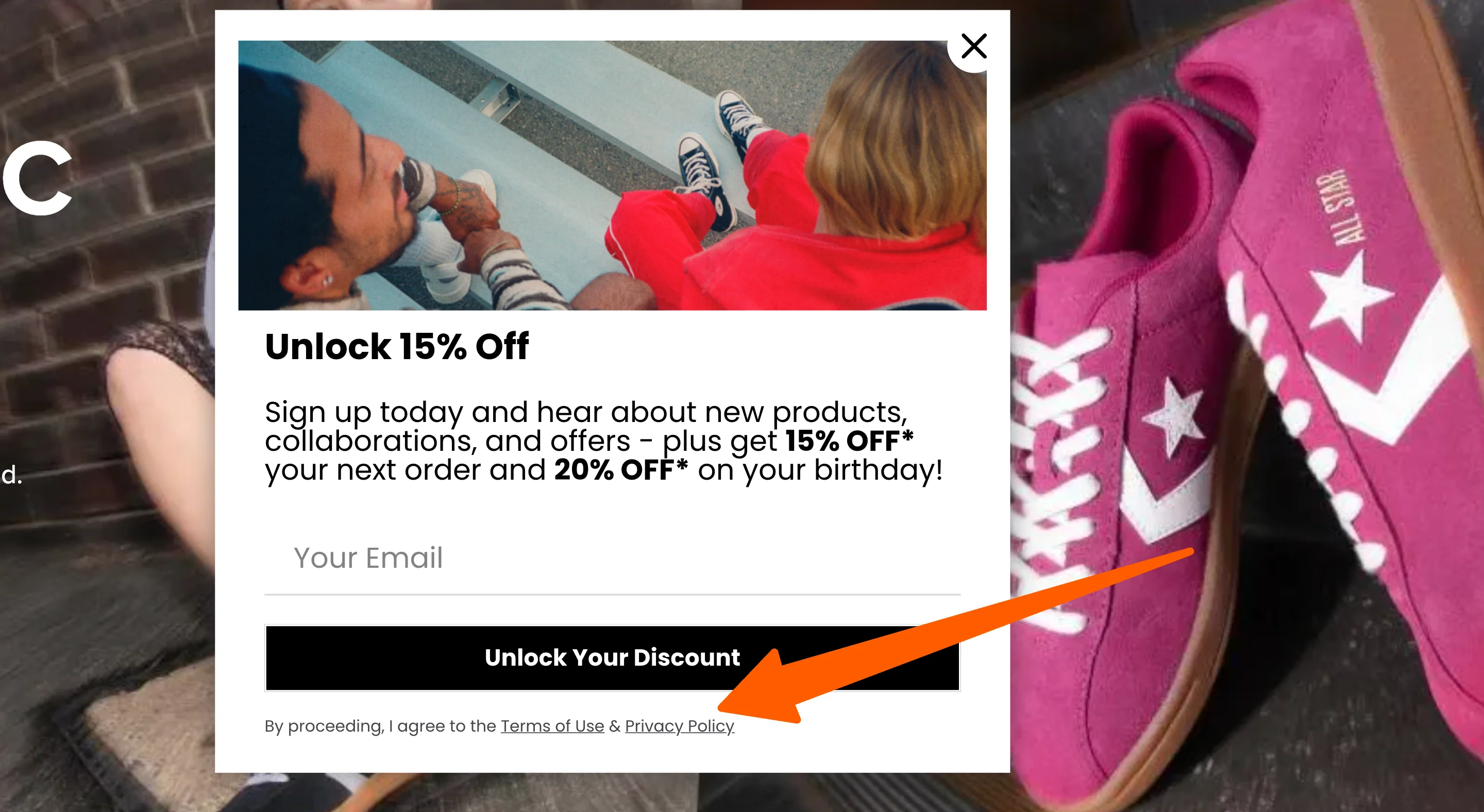

Using popups to grow ecommerce revenue: FAQ
In many cases, yes—but it all comes down to A/B testing.
Multi-step popups consistently outperform single-step versions according to Wisepops research. A recent study shows they can increase lead capture by up to 32% without increasing bounce rates.
The micro-commitment principle in the multi-step design works well: asking for a small favor first (like answering a question) before requesting email addresses can boost signups and drive 8-9× higher engagement while maintaining good completion rates.
Our data from analyzing billions of popup displays in 2025 shows that online businesses are achieving higher conversion rates in 2025 due to better targeting and personalization.
Specifically, the average popup conversion rate increased from 3.80% in 2023 to 4.65% in 2025. Also, our analysis of the top-performing 10% of campaigns in 2025 averaged an impressive CVR of 19.77%.
The average conversion rate of Shopify popups is 8.11%.
Set frequency caps (e.g., once per session or once every 7 days for returning visitors). Use frequency control in your popup tool to be sure; for example, you can activate “stop showing the campaign after the visitor has seen it X times” in frequency settings.
Also, most popup platforms limit the number of popups one visitor can see in one session automatically.
No.
Although over 70% of Shopify businesses use discounts in popups to convert new visitors, you need a sophisticated discount strategy to protect your margins.
Overusing discounts in popups trains customers to wait for sales and deals and attracts price-sensitive buyers who often have low lifetime value.
Consider testing alternatives such as free shipping, gifts with purchase above a certain threshold, loyalty points, and social proof. Reserve discounts for high-intent moments like multiple returning visits to your store, cart abandonment, or multiple previous purchases.
Based on our experience working online businesses, the popups that drive the most revenue are multi-step and behavior-based campaigns with custom offers and contextual timing. Good examples include Nutrimuscle’s three-step welcome flow, OddBalls’ gamified popups, and AI product recommendation popups.
What all these campaigns share is custom targeting, relevance, and value beyond discounts—each campaign feels like a natural part of the shopping journey.
What they also show is that the highest revenue comes from combining multiple popups into a strategy, like:
Exit popups recover abandoning visitors
Cart value-based popups increase average order value with upsells
Product recommendation popups boost cross-sells
If you’d like more campaign examples, check out these case studies to see which popup types bring the most revenue in ecommerce.
Google penalizes intrusive interstitials on mobile that block content. Avoid: popups that are hard to dismiss or anything that prevents access to website content. Use your popup tool's targeting options to create compliant, user-friendly experiences.
Another way is to use other, non-intrusive popup formats like slide-ins, embedded forms, and bars.
Yes, and you should.
Test everything: timing triggers, offers, number of steps, copy, design, signup fields. Even small changes can significantly impact conversion rates. For example, requesting only emails instead of multiple fields can increase conversions by up to 6X, our research found.
Run your experiments long enough to reach statistical significance—use this A/B test sample calculator to know exactly how long.
Learn more: How to do A/B testing for conversion optimization
Track goal and revenue attribution in your popup platform.
For example, you can set up automatic goal tracking and include completed orders, subscriptions, or product page visits as your goals.
Also, with A/B testing, you can monitor attributed revenue per popup, attributed CTR, bounce rate, revenue per visitor, visited pages per visitor, add-to-cart by visitor, and more.
Learn more about goal tracking.
Of course!
Use different strategies for each with customer segmentation and targeting.
For example, acquisition popups capture new emails, phone numbers, segmentation data, and first purchases. Retention popups (targeted at logged-in users) focus on repurchase, product discovery, and improving loyalty program engagement.
Get started
in minutes
Start converting more visitors today.
Get started in minutes and see results right after.


